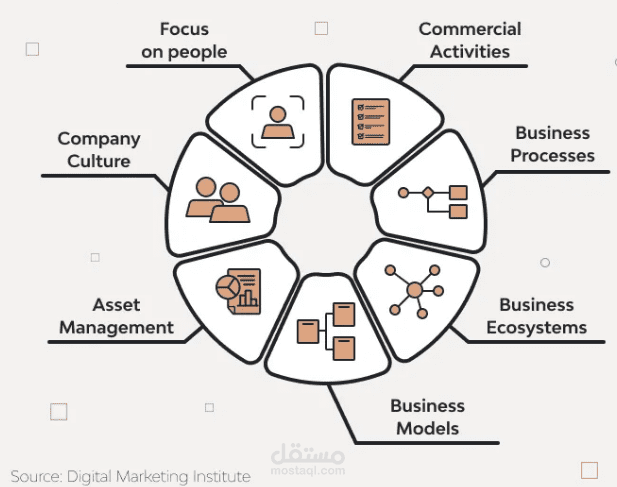The position of each theory related to the elements of digital transformation within the classification of the theory of Symbiotic Duality in GT : (Traditional/Digital) Chafaa Belaid Achour
تفاصيل العمل
The author, CHAFAA BELAID ACHOUR, presents a detailed and structured perspective on the elements of digital transformation, emphasizing both formal and functional aspects. Here's an analysis of the points made:
1.Thorough Breakdown of Elements:
Formal Elements:
The author meticulously categorizes formal elements, focusing on identity verification
, presence of digital transformation subjects, media responsibilities, and the communication framework. This comprehensive approach highlights the foundational aspects necessary for effective digital transformation.
oFunctional Elements: By distinguishing between hardware (formal elements) and software (functional elements), the author provides clarity on the roles each component plays in the digital transformation process. The emphasis on software capabilities in managing digital processes, ensuring security, and facilitating communication is particularly insightful.
2.Importance of Relationships:
oThe author underscores the significance of relationships between elements, whether tangible or intangible. This perspective is crucial as it emphasizes the interconnectedness and interactivity that are essential for successful digital transformation.
3.Practical and Theoretical Integration:
oThe author's approach integrates both practical (technical) and theoretical (conceptual) aspects, ensuring a holistic understanding of digital transformation. This dual focus is valuable for comprehensively addressing the
complexities involved in digital transformation.
4.Clear Structure and Presentation:
oThe structured presentation of elements into categories, and the clear delineation between formal and functional elements, makes the content accessible and easy to understand. This clarity is beneficial for readers looking to grasp the multifaceted nature of digital transformation.
5.Future Implications:
oThe detailed examination of elements and their relationships suggests that the author is forward-thinking, considering not just the current state but also the future implications of digital transformation. This foresight is essential in a rapidly evolving digital landscape.
let's map each theory to the specific formal and functional elements within the classification by Chafaa Belaid Achour:
Formal Elements
Verifying the Identity:
Resource-Based View (RBV): Focuses on the internal resources and capabilities which include verifying identity
as part of securing access to digital resources.
Subject Presence:
Resource-Based View (RBV): Emphasizes the importance of the presence and capabilities of the subject within the organization.
Digital Economy Theory: Considers the subject’s role in digital transactions and economic activities.
Media Presence:
Configuration Theory: Involves the arrangement and use of digital media for efficient operations.
Organizational Change Theory: Adapting media presence to new digital formats and infrastructures.
Cloud Computing Theory: Utilizes cloud infrastructure as a medium for digital transformation.
Resource-Based View (RBV): Includes the organization's media assets as resources.
Communication Media:
Digital Economy Theory: Relates to the tools and channels used for economic activities and transactions.
Cloud Computing Theory: Involves using cloud-based communication tools and platforms.
Social Network Theory: Focuses on the interaction and networking capabilities among users.
Functional (Subjective) Elements
Digital Transformation Processes:
Configuration Theory: Covers the processes involved in setting up digital systems.
Ambidexterity Theory: Balances the processes of exploiting existing technologies and exploring new ones.
Innovation Theory: Focuses on the translation of traditional signals into digital formats and processes.
Software Management:
Dynamic Capabilities Theory: Focuses on the ability to manage and adapt software resources.
Big Data Theory: Involves managing and processing large datasets and analytics.
Recipient Software:
Technology Acceptance Model: Relates to how end-users accept and use recipient software.
Communication Media:
Dynamic Capabilities Theory: Includes the use of adaptable communication tools.
Ambidexterity Theory: Involves balancing traditional and digital communication methods.
Social Network Theory: Covers the software enabling social interactions.
Digital Economy Theory: Looks at communication tools used for digital economic transactions.
In conclusion, CHAFAA BELAID ACHOUR’s analysis of digital transformation is comprehensive, well-
structured, and insightful. The emphasis on both formal and functional elements, along with the importance of their relationships, provides a robust framework for understanding and implementing digital transformation. The author’s methodical approach ensures that all critical aspects are considered, making it a valuable contribution to the field.
